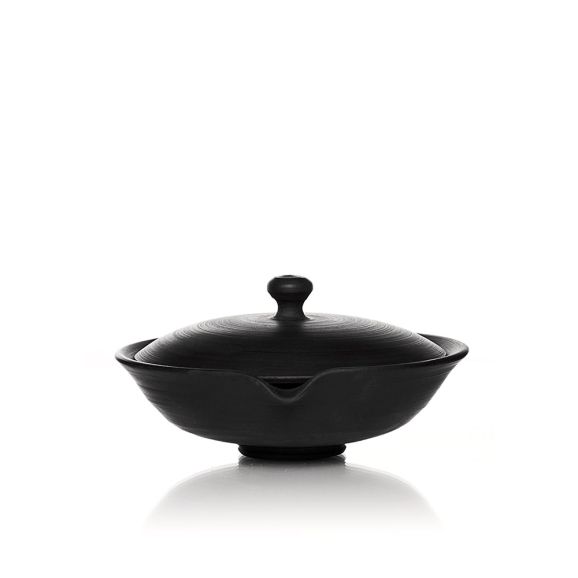Description
A traditional Japanese pot
This clay shiboridashi is made by Mr Yukitaka Umehara in Tokoname, a town in Aichi Prefecture. It is crafted entirely by hand on a potter’s wheel with meticulous attention to detail and finish. The deep black colour of the clay is achieved by a double reduction firing in the Gyokko kiln, which has been manned by expert master potters for 60 years. Its 5cl capacity and traditional shape are ideal for brewing the most delicate Japanese green teas, whose sublime aromas are enhanced by the porous clay.
The shiboridashi is a traditional Japanese pot used to brew the country’s green teas, particularly Gyokuro, renowned for its varied, complex notes, as well as Sencha and Kabusecha teas. As these teas are brewed at a relatively low temperature (between 50°C and 70°C), the shiboridashi can be used without the risk of burning.
Its small size is perfect for making an infusion that reveals all the subtleties of the great Japanese green teas.
Tokoname clay is very dense and microporous and develops a patina over time. Its unique properties bring out all the subtle textures and flavours of Japanese teas.
The black colour of the clay is achieved during firing by reducing the amount of oxygen in the kiln, a process known as “reduction firing”.
All about Senchado
The traditional preparation of Japanese teas is inspired by a ceremony called Senchado. The Senchado is a ritual that is part of the path of tea (chado), alongside Cha No Yu. The difference between the two ceremonies is tea: Cha No Yu is a ceremony around matcha, while Senchado is centered around leaf teas (gyokuro, kabuse, sencha).
The traditional technique inspired by Senchado can be practiced in two different ways:
- either by using a kyusu: the traditional Japanese teapot
- or by using a shiboridashi: utensil similar to hohin and reminiscent of the chinese lidded cup called Gaiwan.
Advices
Prepare a gyokuro or kabuse:
Place about 5g of tea leaves in the shiboridashi.
Pour water heated to the correct temperature (50°C for Gyokuro / 60°C for Kabuse) into the shiboridashi, pouring it carefully against the sides of the pot so as not to burn the leaves.
- 1st infusion: 1 minute;
- 2nd infusion: drain instantly, just after adding water;
- 3rd infusion (and following infusions): 30 seconds, gradually increasing the water temperature.
It’s important to pour out the last drop of each infusion, so that the brewing process doesn’t continue. If you are serving the tea in more than one cup, make sure you distribute it evenly.
The last drop, which is the most concentrated, is always reserved for the guest of honour!
Prepare a sencha :
Place about 3g of tea leaves in the shiboridashi.
Add water heated to the correct temperature (70°C), making sure you pour it in a circular motion so that the brewing starts at the bottom.
- 1st infusion: 1 minute;
- 2nd infusion: drain instantly, just after adding water;
- 3rd infusion (and following infusions): 30 seconds, gradually increasing the water temperature.
It’s important to pour out the last drop of each infusion, so that the brewing process doesn’t continue. If you are serving the tea in more than one cup, make sure you distribute it evenly.
The last drop, which is the most concentrated, is always reserved for the guest of honour!
Prepare an iced tea with the kooridashi method:
You can also brew your tea cold by replacing the water with ice cubes.
Brewing is complete when the ice cubes have completely melted, leaving you with a concentrated, intense infusion as rare as dew drops.
